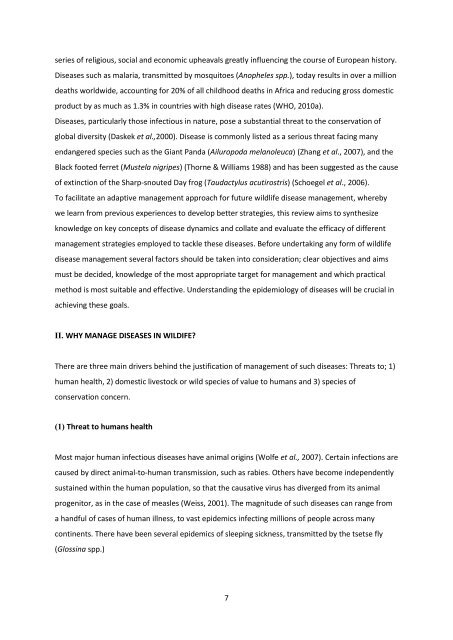Developing an oral bait for badger vaccination - Exeter Research ...
Developing an oral bait for badger vaccination - Exeter Research ...
Developing an oral bait for badger vaccination - Exeter Research ...
Create successful ePaper yourself
Turn your PDF publications into a flip-book with our unique Google optimized e-Paper software.
series of religious, social <strong>an</strong>d economic upheavals greatly influencing the course of Europe<strong>an</strong> history.<br />
Diseases such as malaria, tr<strong>an</strong>smitted by mosquitoes (Anopheles spp.), today results in over a million<br />
deaths worldwide, accounting <strong>for</strong> 20% of all childhood deaths in Africa <strong>an</strong>d reducing gross domestic<br />
product by as much as 1.3% in countries with high disease rates (WHO, 2010a).<br />
Diseases, particularly those infectious in nature, pose a subst<strong>an</strong>tial threat to the conservation of<br />
global diversity (Daskek et al.,2000). Disease is commonly listed as a serious threat facing m<strong>an</strong>y<br />
end<strong>an</strong>gered species such as the Gi<strong>an</strong>t P<strong>an</strong>da (Ailuropoda mel<strong>an</strong>oleuca) (Zh<strong>an</strong>g et al., 2007), <strong>an</strong>d the<br />
Black footed ferret (Mustela nigripes) (Thorne & Williams 1988) <strong>an</strong>d has been suggested as the cause<br />
of extinction of the Sharp-snouted Day frog (Taudactylus acutirostris) (Schoegel et al., 2006).<br />
To facilitate <strong>an</strong> adaptive m<strong>an</strong>agement approach <strong>for</strong> future wildlife disease m<strong>an</strong>agement, whereby<br />
we learn from previous experiences to develop better strategies, this review aims to synthesize<br />
knowledge on key concepts of disease dynamics <strong>an</strong>d collate <strong>an</strong>d evaluate the efficacy of different<br />
m<strong>an</strong>agement strategies employed to tackle these diseases. Be<strong>for</strong>e undertaking <strong>an</strong>y <strong>for</strong>m of wildlife<br />
disease m<strong>an</strong>agement several factors should be taken into consideration; clear objectives <strong>an</strong>d aims<br />
must be decided, knowledge of the most appropriate target <strong>for</strong> m<strong>an</strong>agement <strong>an</strong>d which practical<br />
method is most suitable <strong>an</strong>d effective. Underst<strong>an</strong>ding the epidemiology of diseases will be crucial in<br />
achieving these goals.<br />
II. WHY MANAGE DISEASES IN WILDIFE?<br />
There are three main drivers behind the justification of m<strong>an</strong>agement of such diseases: Threats to; 1)<br />
hum<strong>an</strong> health, 2) domestic livestock or wild species of value to hum<strong>an</strong>s <strong>an</strong>d 3) species of<br />
conservation concern.<br />
(1) Threat to hum<strong>an</strong>s health<br />
Most major hum<strong>an</strong> infectious diseases have <strong>an</strong>imal origins (Wolfe et al., 2007). Certain infections are<br />
caused by direct <strong>an</strong>imal-to-hum<strong>an</strong> tr<strong>an</strong>smission, such as rabies. Others have become independently<br />
sustained within the hum<strong>an</strong> population, so that the causative virus has diverged from its <strong>an</strong>imal<br />
progenitor, as in the case of measles (Weiss, 2001). The magnitude of such diseases c<strong>an</strong> r<strong>an</strong>ge from<br />
a h<strong>an</strong>dful of cases of hum<strong>an</strong> illness, to vast epidemics infecting millions of people across m<strong>an</strong>y<br />
continents. There have been several epidemics of sleeping sickness, tr<strong>an</strong>smitted by the tsetse fly<br />
(Glossina spp.)<br />
7
















